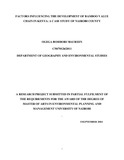| dc.description.abstract | Kenya, like many other developing countries has experienced its fair share of challenges of
balancing between environmental sustainability and development. Key among these challenges
is the deteriorating environment as a result of lack of sustainable livelihood support systems. A
large population of Kenya still relies directly on the natural resources for energy and other forms
of livelihood support. This leads to rapid land use changes and consequent land degradation
which in turn affects the overall wealth of the nation.
Bamboo is a fast growing, renewable, widespread, low cost, plant in the family of grasses with
great potential in environmental conservation and poverty alleviation. Bamboo has over 1500
documented uses and with the ever growing population it can be a good alternative for
conventional resources in Kenya. In Kenya however, the use of bamboo is still minimal and its
full potential is yet to be realized. Bamboo enterprises have slowly been established over the
recent past and Nairobi County has the most developed enterprises of all other counties in
Kenya. The objectives of this study therefore were to: examine the sourcing, processing of raw
bamboo as well as the selling and marketing of bamboo products; explore the development
of the bamboo value chain in Kenya and; evaluate the challenges to development of the bamboo
value chain in Kenya.
Snowball sampling was used in primary data collection using questionnaires and interview
schedules. A total of 7 key informants were interviewed and 37 questionnaires were
administered to bamboo dealers and customers. In addition, observation checklists and
photography were also used in data collection. Secondary data were collected from scientific
journals, books, periodicals, research reports, published and unpublished theses, International
Network for Bamboo and Rattan (INBAR) data bank and the Internet. Quantitative data
were analyzed using measures of central tendencies such as means and percentages. Qualitative
data were organized and categorized into thematic areas of the study objectives. The results were
presented in form of text, table, charts and photographs.
The study established that bamboo was mostly sourced outside Nairobi County as raw poles
especially from Kiambu and Kajiado Counties. Processing was done using simple technology
and selling of bamboo products was mostly done in Nairobi. Bamboo was also used in several
vi
environmental rehabilitation initiatives in the capital. Bamboo nurseries provide bamboo
seedlings for aesthetic uses in the residential areas and city centre; they also provide seedlings
for the city afforestation programmes. The bamboo cottage industry provides items from a
sustainable renewable resource with minimal and bio-degradable wastes. The study also revealed
that bamboo has the potential to replace wood in many aspects but bamboo remained a fairly
untapped resource and compared to most similar products it had no formal marketing structure.
It also showed that the bamboo value chain was affected by ecological, social-cultural, legal,
technological and economic factors. | en_US |

